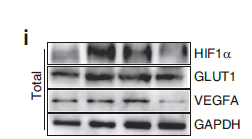
主要信息
Target
GluR-2
Host Species
Rabbit
Reactivity
Human, Mouse, Rat
Applications
WB, IHC, IF, ELISA
MW
99kD (Observed)
Conjugate/Modification
Unmodified
货号: YT1923
规格
价格
货期
数量
200μL
¥3,780.00
现货
0
100μL
¥2,300.00
现货
0
40μL
¥960.00
现货
0
加入购物车


已收藏


收藏
详细信息
推荐稀释比
WB 1:500-1:2000; IHC 1:100-1:300; IF 1:200-1:1000; ELISA 1:20000; Not yet tested in other applications.
组成
Liquid in PBS containing 50% glycerol, 0.5% BSA and 0.02% sodium azide.
特异性
GluR-2 Polyclonal Antibody detects endogenous levels of GluR-2 protein.
纯化工艺
The antibody was affinity-purified from rabbit antiserum by affinity-chromatography using epitope-specific immunogen.
储存
-15°C to -25°C/1 year(Do not lower than -25°C)
浓度
1 mg/ml
实测条带
99kD
修饰
Unmodified
克隆性
Polyclonal
同种型
IgG
相关产品
抗原&靶点信息
免疫原:
The antiserum was produced against synthesized peptide derived from human GluR2. AA range:834-883
展开内容
特异性:
GluR-2 Polyclonal Antibody detects endogenous levels of GluR-2 protein.
展开内容
基因名称:
GRIA2
展开内容
蛋白名称:
Glutamate receptor 2
展开内容
别名:
GRIA2 ;
GLUR2 ;
Glutamate receptor 2 ;
GluR-2 ;
AMPA-selective glutamate receptor 2 ;
GluR-B ;
GluR-K2 ;
Glutamate receptor ionotropic ;
AMPA 2 ;
GluA2
GLUR2 ;
Glutamate receptor 2 ;
GluR-2 ;
AMPA-selective glutamate receptor 2 ;
GluR-B ;
GluR-K2 ;
Glutamate receptor ionotropic ;
AMPA 2 ;
GluA2
展开内容
背景:
Glutamate receptors are the predominant excitatory neurotransmitter receptors in the mammalian brain and are activated in a variety of normal neurophysiologic processes. This gene product belongs to a family of glutamate receptors that are sensitive to alpha-amino-3-hydroxy-5-methyl-4-isoxazole propionate (AMPA), and function as ligand-activated cation channels. These channels are assembled from 4 related subunits, GRIA1-4. The subunit encoded by this gene (GRIA2) is subject to RNA editing (CAG->CGG; Q->R) within the second transmembrane domain, which is thought to render the channel impermeable to Ca(2+). Human and animal studies suggest that pre-mRNA editing is essential for brain function, and defective GRIA2 RNA editing at the Q/R site may be relevant to amyotrophic lateral sclerosis (ALS) etiology. Alternative splicing, resulting in transcript variants enco
展开内容
功能:
Function:Ionotropic glutamate receptor. L-glutamate acts as an excitatory neurotransmitter at many synapses in the central nervous system. Binding of the excitatory neurotransmitter L-glutamate induces a conformation change, leading to the opening of the cation channel, and thereby converts the chemical signal to an electrical impulse. The receptor then desensitizes rapidly and enters a transient inactive state, characterized by the presence of bound agonist.,miscellaneous:The postsynaptic actions of Glu are mediated by a variety of receptors that are named according to their selective agonists. This receptor binds AMPA (quisqualate) > glutamate > kainate.,PTM:Palmitoylated. Depalmitoylated upon glutamate stimulation. Cys-610 palmitoylation leads to Golgi retention and decreased cell surface expression. In contrast, Cys-836 palmitoylation does not affect cell surface expression but regulates stimulation-dependent endocytosis.,RNA editing:Partially edited. Fully edited in the brain. Heteromerically expressed edited GLUR2 (R) receptor complexes are impermeable to calcium, whereas the unedited (Q) forms are highly permeable to divalent ions.,similarity:Belongs to the glutamate-gated ion channel (TC 1.A.10) family.,subunit:Homotetramer or heterotetramer of pore-forming glutamate receptor subunits. Tetramers may be formed by the dimerization of dimers. May interact with MPP4. Forms a ternary complex with GRIP1 and CSPG4. Interacts with PRKCABP, GRIP1 and GRIP2.,
展开内容
细胞定位:
Cell membrane ; Multi-pass membrane protein . Endoplasmic reticulum membrane ; Multi-pass membrane protein . Cell junction, synapse, postsynaptic cell membrane ; Multi-pass membrane protein . Cell junction, synapse, postsynaptic density membrane ; Multi-pass membrane protein . Interaction with CACNG2, CNIH2 and CNIH3 promotes cell surface expression (By similarity). Displays a somatodendritic localization and is excluded from axons in neurons (By similarity). .
展开内容
组织表达:
Brain,
展开内容
研究领域:
>>cAMP signaling pathway ;
>>Neuroactive ligand-receptor interaction ;
>>Circadian entrainment ;
>>Long-term potentiation ;
>>Retrograde endocannabinoid signaling ;
>>Glutamatergic synapse ;
>>Dopaminergic synapse ;
>>Long-term depression ;
>>Amyotrophic lateral sclerosis ;
>>Huntington disease ;
>>Spinocerebellar ataxia ;
>>Pathways of neurodegeneration - multiple diseases ;
>>Cocaine addiction ;
>>Amphetamine addiction ;
>>Nicotine addiction
>>Neuroactive ligand-receptor interaction ;
>>Circadian entrainment ;
>>Long-term potentiation ;
>>Retrograde endocannabinoid signaling ;
>>Glutamatergic synapse ;
>>Dopaminergic synapse ;
>>Long-term depression ;
>>Amyotrophic lateral sclerosis ;
>>Huntington disease ;
>>Spinocerebellar ataxia ;
>>Pathways of neurodegeneration - multiple diseases ;
>>Cocaine addiction ;
>>Amphetamine addiction ;
>>Nicotine addiction
展开内容
信号通路
Organismal Systems >> Nervous system >> Glutamatergic synapse
Organismal Systems >> Nervous system >> Dopaminergic synapse
Human Diseases >> Neurodegenerative disease >> Amyotrophic lateral sclerosis
Human Diseases >> Neurodegenerative disease >> Huntington disease
Human Diseases >> Neurodegenerative disease >> Spinocerebellar ataxia
Human Diseases >> Neurodegenerative disease >> Pathways of neurodegeneration - multiple diseases
Environmental Information Processing >> Signal transduction >> cAMP signaling pathway
文献引用({{totalcount}})
货号: YT1923
规格
价格
货期
数量
200μL
¥3,780.00
现货
0
100μL
¥2,300.00
现货
0
40μL
¥960.00
现货
0
加入购物车


已收藏


收藏
Recently Viewed Products
Clear allToggle night Mode
{{pinfoXq.title || ''}}
Catalog: {{pinfoXq.catalog || ''}}
Filter:
All
{{item.name}}
{{pinfo.title}}
-{{pinfo.catalog}}
主要信息
Target
{{pinfo.target}}
Reactivity
{{pinfo.react}}
Applications
{{pinfo.applicat}}
Conjugate/Modification
{{pinfo.coupling}}/{{pinfo.modific}}
MW (kDa)
{{pinfo.mwcalc}}
Host Species
{{pinfo.hostspec}}
Isotype
{{pinfo.isotype}}
产品 {{index}}/{{pcount}}
上一个产品
下一个产品
{{pvTitle}}
滚轮缩放图片
{{pvDescr}}





















